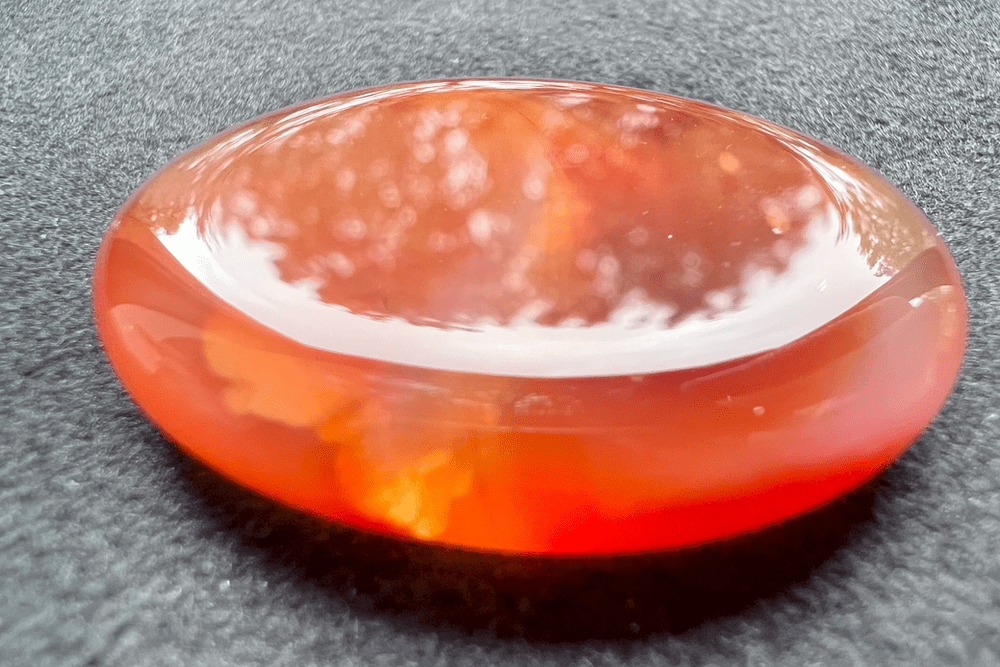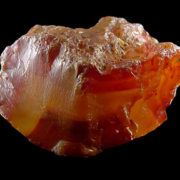Carnelian: Properties, Uses and Virtues
Carnelian: a timeless gem!
Carnelian, a gemstone with warm shades of red and orange, has been prized for centuries for its charm and mystical properties.
Renowned for its connection with creativity and vitality, carnelian has captured the hearts of gem lovers and spiritual seekers alike.
Follow us on a fascinating journey to explore the geological formation, historical significance and metaphysical properties of this gem.

Carnelian: Table of contents
- Carnelian Geological Formation
- Rough Carnelian – Raw Beauty Revealed
- Sources – Carnelian’s Worldwide Reach
- Historical Significance of Carnelian – Through the Ages
- Metaphysical Properties of Carnelian – Illuminating energies
- Carnelian Varieties
- Carnelian Colors
- Carnelian’s Durability and Wearability
- Carnelian Enhancements – Preserving Natural Beauty
- Synthetic Carnelian – Nature in the Laboratory
- Imitations of Carnelian – Discerning the Authentic
- Caring for Carnelian – Preserving its natural beauty
Carnelian Geological Formation
Carnelian, a variety of chalcedony, and therefore of quartz, is formed by a combination of volcanic and sedimentary processes. This gemstone is generally found in sedimentary rocks, agate nodules and volcanic rocks.
Its formation involves the interaction of silica-rich solutions with host rocks, giving rise to this magnificent crystal in the Earth’s crust.
Rough Carnelian – Raw Beauty Revealed
As a variety of chalcedony, carnelian, like most polycrystalline materials, has no specific crystalline form. Its rocky composition means that it is made up of many small crystals.
Sources – Carnelian’s Worldwide Reach
Carnelian is found in many parts of the world, including India, Brazil, Uruguay and Egypt. Each source contributes to unique variations in color and pattern.
Historical Significance of Carnelian – Through the Ages
Carnelian, a gemstone prized for its vivid red hues and mystical charm, has fascinated ancient civilizations for centuries. Throughout history, carnelian has played a key role in jewelry, amulets and seals, symbolizing courage, protection and vitality.
Ancient Egypt:
In ancient Egypt, carnelian was much more than a beautiful stone; it was a symbol of life and rebirth. Believing that it protected the soul in the afterlife, the Egyptians commonly used it in funeral ceremonies and ornaments. Carnelian’s fiery color resonated with the beneficent sun, giving it deep spiritual significance.
Ancient Rome:
The Romans cherished carnelian for its bewitching appearance and metaphysical properties. They engraved the stone into seal rings, seals and amulets to reinforce their power and authority. Carnelian was considered a stone of courage, inspiring warriors to face battle with strength and valour.
In addition to its protective qualities, carnelian was revered for its association with vitality and creativity. Throughout ancient cultures, it was believed to stimulate energy and inspire passion, making it a prized gemstone for artists, poets and leaders.
Nowadays:
Beyond its physical beauty, carnelian’s rich heritage of history and symbolism has left a lasting imprint on human culture. It continues to be celebrated as a stone of strength, protection and inspiration, touching those who seek to embrace its timeless charm and mystical significance.
Metaphysical Properties of Carnelian – Illuminating energies
In the realm of metaphysical beliefs, carnelian is considered a stone of motivation, creativity and courage. It is believed to enhance vitality and inspire action, empowering the wearer to overcome obstacles and achieve goals.
Like many stones of this color, it is also known as a healing and blood invigoration stone.
Carnelian Varieties
Carnelian, a variety of chalcedony, and therefore quartz, has no specific varieties to mention.
Carnelian Colors
Carnelian captivates with its warm, flamboyant hues, ranging from deep orange-red to vibrant orange-yellow shades.
Some specimens may feature distinct bands or patterns, adding to the stone’s appeal.
The stone’s intense colors evoke passion, creativity and vitality, making carnelian a prized gemstone for expressing emotions and sparking inspiration.
Carnelian’s Durability and Wearability
Carnelian has excellent durability, with a hardness of between 6.5 and 7 on the Mohs scale. This level of hardness ensures that carnelian is suitable for various types of jewelry and can withstand the rigors of daily wear, preserving its beauty over time.
Carnelian Enhancements – Preserving Natural Beauty
Natural carnelian can be easily waxed or oiled. This treatment improves shine and softness and is widely accepted. It can also be easily reproduced at home.
Because of its high iron content, carnelian is also highly sensitive to heat treatment, even by simple sunlight. The resulting colors will be darker and redder.
As a general rule, it’s best to assume that most carnelian stones have been heat-treated.
Synthetic Carnelian – Nature in the Laboratory
Synthetic carnelian, like all chalcedony, has not been commercially synthesized. Most “synthetic carnelians” on the market are imitations.
Imitations of Carnelian – Discerning the Authentic
Carnelian can sometimes be imitated or misrepresented by yellowish or brownish microcrystalline quartz heated to resemble reddish carnelian, glass, tinted low-grade rock and plastic.
Buyers should exercise caution to ensure that they are buying real carnelian and not imitation tinted agate or glass.
Buying from reputable, certified gem dealers is essential to guarantee the stone’s authenticity.
Caring for Carnelian – Preserving its natural beauty
Caring for carnelian jewelry is essential to preserve its timeless beauty. To preserve its brilliance, avoid exposing it to aggressive chemicals and keep it separate from other gems to avoid scratches.
Clean carnelian jewelry gently with mild soapy water and a soft brush, taking care to preserve its lasting charm. If coated with wax or oil, treatment can be repeated if necessary.



Leave a Reply
Want to join the discussion?Feel free to contribute!